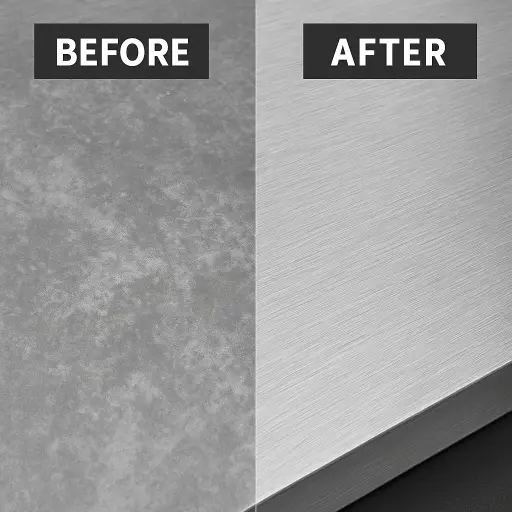Step-by-Step Guide: How to Clean Aluminum Oxidation
Aluminum is prized for its lightweight strength and natural corrosion resistance. However, aluminum corroded surfaces can still develop oxidation over time, leading to unsightly tarnish and potential damage. This guide will walk you through how to clean aluminum oxidation effectively, providing actionable steps for engineers, sourcing managers, and business owners looking to maintain or restore aluminum parts.
Table of Contents
- Understanding Aluminum Oxidation
- Tools and Materials You Need
- Step-by-Step: How to Clean Aluminum Oxidation
- Step 1: Inspect and Prepare the Surface
- Step 2: Choose the Right Cleaning Solution
- Step 3: Apply and Scrub Gently
- Step 4: Rinse and Neutralize
- Step 5: Polish and Protect
- Best Products for Cleaning Oxidized Aluminum
- Case Study: Industrial Aluminum Corrosion Treatment
- Conclusion
Understanding Aluminum Oxidation
Before diving into how to clean oxidized aluminium, it’s essential to understand why it happens.
Does aluminum oxidize? Yes. When aluminum reacts with oxygen, it forms a thin oxide layer that protects the underlying metal. However, in harsh environments (especially outdoors), this layer can degrade, leading to aluminium tarnish and white corrosion spots.
Related reading: Aluminium Corrosion Protection
Key Facts:
| Feature | Detail |
|---|---|
| Does aluminum oxidize? | Yes, forming a protective oxide layer |
| Aluminum tarnish color | Dull gray to white powdery spots |
| Common causes | Moisture, salt, industrial pollutants |
Tools and Materials You Need
To effectively remove corrosion from aluminum, gather the following:
| Tools | Materials |
|---|---|
| Soft-bristle brush | White vinegar |
| Microfiber cloth | Baking soda |
| Plastic scraper | Aluminum polish |
| Protective gloves | Mild detergent |
Tip: Always wear gloves to prevent skin irritation during the aluminum corrosion treatment process.
Step-by-Step: How to Clean Aluminum Oxidation
Here’s a clear, actionable guide to cleaning oxidized aluminum:
Step 1: Inspect and Prepare the Surface
- Check for deep pits or structural damage caused by aluminum corroded surfaces.
- Lightly wipe off dust or loose debris using a dry microfiber cloth.
Step 2: Choose the Right Cleaning Solution
- For light oxidation, vinegar removes oxidation from aluminum effectively.
- For heavier corrosion, create a paste using baking soda and water.
| Problem | Solution |
|---|---|
| Light tarnish | Vinegar soak |
| Heavy corrosion | Baking soda paste |
Tip: Test your cleaning agent on a small area first to avoid surface damage.
Step 3: Apply and Scrub Gently
- Dip a soft brush or cloth into your cleaning solution.
- Gently scrub the oxidized or aluminium tarnish areas.
- Avoid using steel wool or abrasive pads that may scratch the surface.
Step 4: Rinse and Neutralize
- After cleaning, rinse thoroughly with clean water.
- Wipe the surface dry immediately to prevent further oxidation.
To neutralize aluminum corrosion, ensure no acidic residues (like vinegar) remain on the surface after cleaning.
Step 5: Polish and Protect
- Apply an aluminum polish to restore shine.
- Consider using a clear protective coat to slow down future oxidation.
Explore: How to Treat Aluminum Corrosion
Best Products for Cleaning Oxidized Aluminum
Here are some tested solutions for treating aluminum corrosion:
| Product Type | Recommended For |
|---|---|
| Vinegar | Mild oxidation |
| Baking Soda Paste | Medium oxidation |
| Commercial Aluminum Cleaners | Heavy corrosion |
| Protective Coatings | Long-term corrosion resistance |
Case Study: Industrial Aluminum Corrosion Treatment
Client: A machinery parts manufacturer
Problem: Outdoor stored aluminum components showed severe aluminum corrosion and tarnish.
Solution:
- Initial cleaning with commercial aluminum corrosion cleaner.
- Neutralization rinse with distilled water.
- Final application of clear corrosion-resistant coating.
Result:
- 95% recovery of surface brightness
- 60% longer life expectancy after aluminum corrosion treatment
Key Takeaway: Fast, proactive treatment drastically extends the lifespan of aluminum parts.
Conclusion
Maintaining aluminum components doesn’t have to be complicated. By understanding how to clean oxidized aluminium and applying the right methods, you can prevent deep damage and ensure longer product life.
Whether you’re dealing with industrial parts, customized components, or sourcing critical supplies, mastering cleaning oxidised aluminium techniques ensures better performance and aesthetics.
For further corrosion protection strategies, check out our detailed guide on Aluminium Corrosion Protection.

